Abstract
Graphene-based devices are planned to augment the functionality of Si and III-V based technology in radio-frequency (RF) electronics. The expectations in designing graphene field-effect transistors (GFETs) with enhanced RF performance have attracted significant experimental efforts, mainly concentrated on achieving high mobility samples. However, little attention has been paid, so far, to the role of the access regions in these devices. Here, we analyse in detail, via numerical simulations, how the GFET transfer response is severely impacted by these regions, showing that they play a significant role in the asymmetric saturated behaviour commonly observed in GFETs. We also investigate how the modulation of the access region conductivity (i.e., by the influence of a back gate) and the presence of imperfections in the graphene layer (e.g., charge puddles) affects the transfer response. The analysis is extended to assess the application of GFETs for RF applications, by evaluating their cut-off frequency.
1. Introduction
Two-dimensional materials (2DMs) have awakened the great interest of the nanotechnology community during the last decade [1]. Their striking physical properties, intrinsically different from their 3D counterparts, open a vast field of opportunities only partially exploited so far. Among these alternatives, 2DMs find a natural spot in electronics, where their monoatomic thickness makes them especially attractive to overcome the hurdles related to the transistor scaling-down [2].
Graphene is not only the pioneer, but also the most singular member of the 2DM family [3]. It is characterized by a gapless Dirac-cone bandstructure, where electrons and holes have symmetric dispersion relationships. The literature is abundant in Graphene Field-Effect Transistors (GFETs) [4,5,6], where this particular band structure is manifested in an ambipolar behaviour and a poor ratio (direct consequence of the easiness to switch the carrier transport from electrons to holes and vice versa). This issue jeopardizes the use of GFETs in digital electronics, although a successful demonstration has been achieved in [7]. In radio-frequency (RF), however, graphene has revealed itself as an interesting candidate [8], and devices with cut-off frequencies of hundreds of GHz have already been demonstrated [9,10], even reaching wafer scale integration [11], or being applied for flexible electronics [12,13]. The main strategies to boost GFETs performance have consisted of the scaling-down of the gate oxide thickness [4,14], the encapsulation in hexagonal boron nitride [15] or the improvement in the quality of the graphene-insulator stack [7,16]. In particular, clean self-aligned fabrication, based in pre-deposited gold, has been proposed in [17]; while the self-aligned transfer of the gate stack (processed in a sacrificial substrate) has been detailed in [18].
The transfer characteristic of experimental GFETs is V-shaped, but very often shows an asymmetry with respect to the Dirac voltage [19], usually associated with different electron and hole mobilities. These mobility dissimilarities are the common path to handle the device response asymmetry, leaving out of the spot the relevance of the gate underlapped areas [15,20,21]. These access regions (intended to minimize the capacitance coupling between the gate and the source and drain) impact, however, strongly on the GFET electrical behaviour, as they constitute a noticeable resistance pathway for carrier transport. Partial attempts on the modelling of this issue have been discussed from an analytical resistance-based perspective in [20,22], but a comprehensive study of their impact in the GFET performance is still lacking [18]. In this work, we direct our attention to this asymmetric response of GFETs and, by means of detailed numerical simulations, we explain such effect studying the impact of the access regions in the transfer characteristic as well as in the RF performance of such devices.
The rest of the document is organized as follows. Section 2.1 presents the numerical model employed for this study. To check and validate it we compare, in Section 2.2, the simulated transfer response of two GFETs against the corresponding experimental measurements. Section 2.3 contains a thorough analysis of the access resistances and a discussion of its influence on the cut-off frequency, . Finally, the main conclusions are drawn in Section 3.
2. Results
2.1. Device Simulation
A schematic depiction of the physical structure of the simulated GFET is shown in Figure 1. The graphene flake is sandwiched in between a top insulator layer, with thickness and dielectric permittivity , and an insulating substrate, with thickness and dielectric permittivity . Both oxides are assumed thick enough as to neglect any tunnelling current through them. A four-terminal device is considered, with a front gate extending over a length (the device channel length), giving rise to two under-lapped regions of length (the access region length) that connect it with the source and drain terminals. The back gate, when considered, extends all along the structure including the channel as well as the access regions. , , and stand for the front gate, back gate, and drain terminal biases respectively, while the source terminal, , is assumed to be grounded. The total resistance of this structure, , can be schematically split into the series combination of three resistances corresponding to the source access region (), the channel region () and the drain access region ().
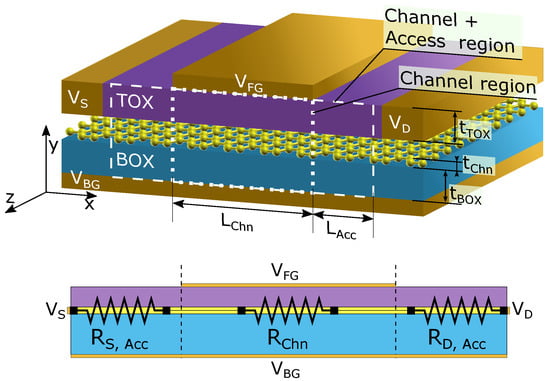
Figure 1.
Schematic of the simulated GFET and the characteristic resistances of the device. The dashed and dotted rectangles indicate the regions used for the different simulations. While the dotted rectangle only encompasses the channel region, the dashed one includes the access regions.
To determine the response of GFET devices, we have self-consistently solved the coupled Poisson, Drift-Diffusion and continuity equations [23,24]. For the device modelling, we have considered a longitudinal section of the GFET, assuming invariance along the device width (z). The resulting 2D Poisson equation is given by:
where V is the electrostatic potential; is the net charge density in the structure, that comprises the mobile (electrons and holes) and fixed (dopants) charges; and is the dielectric permittivity.
The Drift-Diffusion transport equation is formulated in terms of the pseudo-Fermi level () as proposed in [25]:
where is the potential associated with this level and () is the graphene electron (hole) 1D density profile. Here, () stands for the electron (hole) mobility. Due to the extreme confinement, the carriers are supposed to move only along the transport direction (x). J must comply with the continuity equation that, under steady-state conditions, is formulated as: . Ohmic contacts are assumed at the source and drain terminals, with the Fermi level at the source grounded, , and at the drain given by . The equation system is then iteratively solved for each set of terminal biases, until a convergence threshold is achieved for the potential and charge concentrations.
In addition to the mobile charge and dopants in the graphene layer, we account for the existence of puddles [26,27]. Their associated charge density, , is assumed constant and added to both electron and hole charge densities [28]. In this way, puddles impact on the overall graphene layer conductivity while conserving a neutral net charge character.
2.2. Validation
To assess the capability of the numerical simulator to reproduce and explain the experimental results, we have first validated it against the devices fabricated in [29,30]. Both are GFETs based on monolayer graphene embedded between a SiO layer, which acts as a substrate, and a YO layer, which acts as a front gate dielectric. In both cases, this YO layer is 5 nm thick while the substrate is 300 nm thick in [29], and 286 nm thick in [30]. For the device presented in [29], the distance between the source and drain contacts is 1.5 m and the front gate length is 600 nm, while in [30] the device is 8.2 m long and its front gate is 7 m long. In other words, in both experimental devices the gate contact does not cover the whole region between source and drain contacts, thus creating two symmetrical under-lapped regions at both channel edges; namely, the device access regions. To reproduce the data reported in [29], the same mobility is assumed for both types of carriers, electrons and holes () with a value of 90 cmVs, and a puddle charge density of 7 cm is considered. N-type chemical doping of 10 cm is defined for the graphene layer. To account for the graphene-metal contact resistances, which are in series with the total resistance of the structure, , we include two additional 100 nm long N-type doped regions (5 cm) in both source and drain ends [31]. The back gate is grounded and is set to 0.1V. To fit the data presented in [30], the values used are 1091 cmVs, cm and the graphene layer chemical doping is set to 10 cm. The back gate is also grounded and is set to 0.05 V. The experimental and simulated transfer characteristics are shown in Figure 2a [29] and Figure 2b [30]. The simulated I-V characteristics match very accurately with the experimental results in the whole range of biases and are able to catch the transfer response of the electron and hole branches, especially in Figure 2b.

Figure 2.
Comparison between the simulation results and the experimental data extracted from [29] (a) and [30] (b).
2.3. Access Region Analysis
As mentioned in Section 1, the existence of access regions and puddles is a very common scenario in the experimental realization of GFETs due to the difficulties to precisely control the fabrication process in this early stage of the technology. They modify the behaviour of the transistors, in many cases determining their performance, and therefore deserving a particular attention that is usually obliterated. Hence, once the numerical simulator has been validated, we now proceed to analyse the effect of the access regions.
2.3.1. Including the Access Regions
To begin with, we have considered a test structure where the front gate covers the whole device length (i.e., suppressing the access regions) and compared the results with those obtained later when access regions are included. These scenarios are illustrated in Figure 1 by the dotted and dashed frames respectively. The material stack comprises a monolayer graphene sandwiched between a 3 nm thick HfO layer (front gate insulator) and a 27 nm thick SiO layer (back gate insulator). The front gate, which determines the channel length (), is 100 nm long and both access regions are 35 nm long (). Electron and hole mobilities are equal ( cmVs) and no chemical doping or puddle charge density is considered in the graphene layer.
The transfer characteristic of the device without access regions is depicted in Figure 3a for different values of . As can be observed, the device exhibits the ambipolar V-shaped response of an ideal GFET. The minimum of the curve defines the Dirac voltage () that is shifted to larger when increases. The behaviour is perfectly symmetric with respect to , reflecting the symmetry between electron and hole properties.
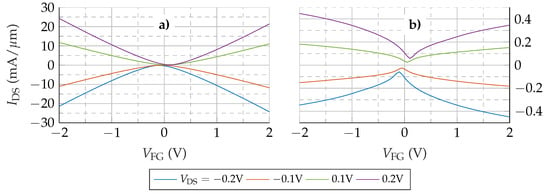
Figure 3.
curves of the device without (a) and with (b) access regions.
Next, the GFET including the access regions is investigated. The resulting transfer characteristic is shown in Figure 3b. Comparing Figure 3b and Figure 3a, a marked variation of the GFET response is observed. First, there is a notable decrease in the values of , around a factor ×100. Second, the transfer characteristic shows a saturation trend for high which resembles much better the experimental response. Third, and more important, the characteristic is no longer symmetric with respect to , though the mobility is identical for both kinds of carriers.
To provide insights into these changes, the resistance of the different regions of the device are calculated. Figure 4 shows their values for 0.1 V and 0.2 V. Mirror symmetric behaviour is observed for positive . The access region resistances, and , show values comparable with the channel resistance, . At the Dirac voltage, where the channel resistivity is the highest, commands the series association, but still the access regions have a noticeable contribution. For V the total resistance is mainly determined by and . Consequently, the total resistance () is not controlled just by the channel conductivity and, therefore, by the gate terminal. The weak dependence of and on is reflected in the trend to saturation. As the values of and are higher than the channel resistance, a larger fraction of drops in the access regions. This fact reduces the potential at the channel edges with respect to the no-access-regions scenario, reducing the output current. In addition, the dependence is not symmetric, so neither are the access region potential drops, resulting into a non-symmetric reduction of the output current, that is, an asymmetric curve shown in Figure 3b. This lack of equivalence between the source and drain access regions is explored in detail in the following section.

Figure 4.
Resistance of the three device regions (channel, source and drain access regions) compared with the total resistance as a function of the gate potential, for two values: −0.1 V (solid) and −0.2 V (dashed).
2.3.2. Gate Misalignment
In the previous section, we assumed that the gate is perfectly aligned in the middle of the channel leading to identical source and drain access regions () at both ends. A more realistic scenario should consider the impact of having non-equal and , enabling us to test the non-equivalent role of and on the GFET response. For this purpose, we have analysed GFETs where the top gate contact is not placed in the centre of the structure, resulting in access regions of different length. In particular, we have kept (or ) equal to 35 nm while (or ) is modified. Specifically, we considered four scenarios: (i) short source, (ii) short drain, (iii) long source and (iv) long drain. The length of the short and long regions is set to 17.5 nm and 70 nm, respectively. The curves, along with the resistances , and obtained in each case, are depicted in Figure 5.
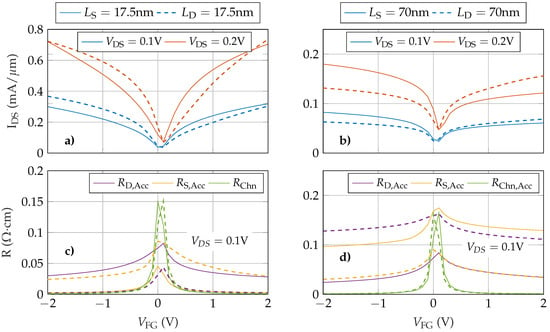
Figure 5.
Transfer response (a,b) and structure resistances (c,d) as a function of the gate bias. These results are obtained reducing the length of either the source (a,c, solid lines) or drain access region (b,d, dashed lines) down to 17.5 nm, and increasing the length of either the source (a,c, solid lines) or the drain access region (b,d, dashed lines) up to 70 nm.
As expected, there are significant differences between devices. Shortening either the source or the drain access regions results in a higher output current (Figure 5a) and reduces both its saturation and its asymmetry with respect to the elongated scenario (Figure 5b). When comparing the shorter regions (Figure 5a) it is clearly observable that the = 17.5 nm device (solid lines) has a more symmetric response than the = 17.5 nm (dashed lines). This is more evident for = 0.1 V and emphasizes the role of the source access region with respect to the drain access region. An equivalent conclusion can be achieved from the elongated devices (Figure 5b). The longer results in an increased asymmetry between both branches. These results can be explained by analysing the resistances of the structure. Figure 5c,d show , and as a function of for = 0.1 V. When any access region is shortened (Figure 5c), its resistance is similar or lower than the channel resistance regardless . The longer region resistance controls the total current (except for close to zero). When one of the regions is enlarged this effect is emphasized. The transfer responses in Figure 5b are clearly saturated due to the dominant role in the total conductivity of the longer access region.
2.3.3. Impact of Electrostatic Doping and Puddles
To reduce the impact of the access regions in the overall device performance, it is possible to increase their conductivity by means of an electrostatic doping using the back-gate terminal. In the following we analyse how the back gate influences the GFET behaviour. Figure 6 shows the transfer characteristic for three different values of : −1 V, 0 V and 1 V (solid lines). For 0 V the results are quite similar to the scenario without back gate. In the other two cases, depending on the polarity of , electrons or holes are accumulated in the graphene layer. As a result, the P-type (N-type) branch is enhanced for 1 V ( 1 V), regardless the value of . As in the previous scenario, the origin of this behaviour can be traced back to the resistance associated with the access regions.
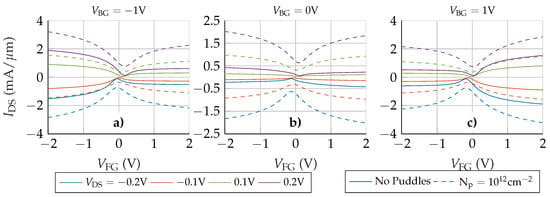
Figure 6.
characteristics of the complete structure when three different back gate potentials are used (−1 V (a), 0 V (b) and 1 V (c)). Solid lines correspond to the device without puddles and dashed lines to the device with cm.
Figure 7 depicts the device resistances for different and 0.1 V (without puddles, solid lines). For 1 V the total resistance near the Dirac voltage is dominated by . When is increased above , the symmetry of is kept since it is mostly controlled by the front gate, while the asymmetry of and is exacerbated due to the electrostatic doping, giving rise to the large asymmetry observed in the transfer response, in Figure 6. In particular, the asymmetric step-like dependence of the access resistances on (for V) is the result of the electrostatic competition between the front and back gates to control the access regions closer to the channel. When and have the same polarity, they add their electric forces to increase the carrier density in the aforementioned zones, increasing the conductivity and therefore lowering the whole access resistance. However, if is opposite to , both gates compete to accumulate different types of charges, resulting in a depleted region close to the channel edges that decreases the conductivity and increases the overall access region resistances. An equivalent conclusion was achieved in [26] where a strong modulation of the total resistance by two additional gates is observed, as in Figure 7.
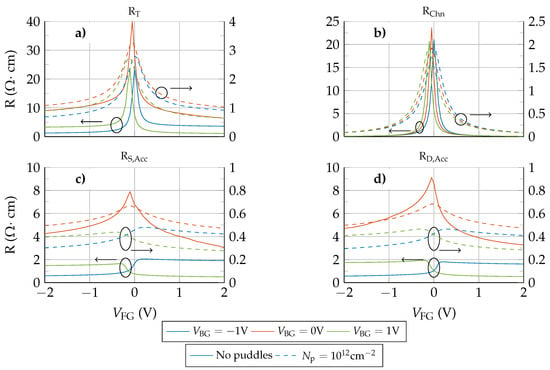
Figure 7.
Total (a), channel (b), source (c) and drain (d) resistances for different back gate biases and 0.1 V. Solid lines (referred to the left axis) correspond to the no puddles scenario while dashed lines (referred to the right axis) depict the values obtained when a puddle concentration of cm is considered.
An additional aspect that cannot be overlooked is the effect of the presence of puddles in the graphene layer [27,32]. To shed light on this issue Figure 6 includes the response when a puddle charge density of cm is considered (dashed lines). Two major changes are observed after including the puddles: (i) the total current is increased, and (ii) the asymmetry is clearly reduced. These changes derive from the equal contribution of puddles to the conductivity of both electrons and holes, and explain why the curves of some experimental devices are reasonably symmetric close to the Dirac voltage, where the conductivity of puddles is dominant. In this situation, the conductivity of the whole graphene layer is increased for electrons and holes, in contrast with the electrostatic doping generated by the back gate. This non-selective improvement of the conductivity is translated into the resistances of the device: Figure 7 includes the relation for cm (dashed lines). The step-like behaviour of and is softened when the puddles are included, resembling the V case.
2.3.4. RF Performance
Finally, to determine the impact of the access regions in the RF performance, we evaluate the cut-off frequency, , as a RF figure of merit (FoM). The value of is calculated as in [33,34]:
where is the transconductance and the front gate capacitance.
Figure 8 shows as a function of under two scenarios: no puddles (solid lines) and cm (dash-dotted lines). To assess the impact of the access regions, the performance of the intrinsic device (structure indicated by the dotted rectangle in Figure 1) is depicted too (dashed lines). In addition, to evaluate the magnitude of the calculated values, the experimental measurements of reported in [35] and [36] are indicated by the arrows on the right side axis of Figure 8. Despite the device structure and the bias conditions are different, the channel lengths of these experimental devices are similar to the ones simulated here (144 nm [35] and 140 nm [36]), and therefore constitute a good reference. Importantly, a de-embedding procedure was carried out for the RF measurements of these experimental devices by using specific “short” and “open” structures with identical layouts in order to remove the effects of the parasitics associated with the pads and connections, but not the contact and access region resistances.
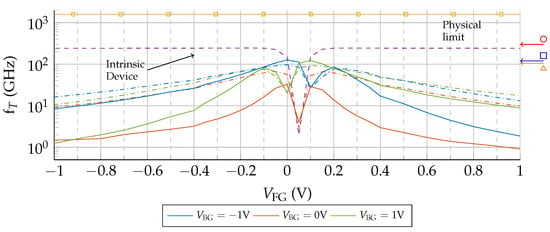
Figure 8.
of the back-gated device with access regions under two scenarios: no puddles (solid lines) and cm (dash-dotted lines). The values obtained for the intrinsic device are depicted by the purple dashed line. The arrows labelled by marks on the right side axis indicate the values of extracted from [35] (circle) and [36] (square and triangle). The yellow line indicates the physical limit for graphene , determined by the transit time , with the Fermi velocity cm/s and 100 nm (squares).
Including the access regions results in a quite different response compared with the intrinsic device, as the associated parasitic resistances provoke a bias dependent decay of . Considering the scenario without puddles, when the back gate is properly biased, is considerably improved. If we analyse Figure 8 in combination with Figure 7, those combinations of , for which the curve shows its minimum values, are those for which shows a greater improvement. When is higher, is spoiled with respect to the V case. This relation between the access region conductivity and the improvement of the RF performance was experimentally observed in [21] where a higher was demonstrated when a GFET with two additional electrodes was properly biased to control such conductivity. When puddles are included, the channel conductivity increases, what reduces the control of the back-gate bias, and simultaneously results in a more symmetric dependence.
3. Conclusions
GFETs have been thoroughly studied in order to assess the impact of the access regions in the device performance. The validation of our approach against two experimental devices spotlights the importance of these regions as well as the presence of puddles to reproduce the state-of-the-art technology. When the access regions are considered, the transfer response reveals a lower, saturated and asymmetric characteristic that is not observed in their absence. To explore the impact of a variable conductivity of these regions we have included a back gate in the structure able to introduce an electrostatic doping. The back gate increases the output current as well as the asymmetry of the transfer characteristic. The latter effect is explained in terms of the competition of the back and front gates that results in a depletion of the amount of carriers close to the channel edges when both biases have an opposite polarity. The influence of puddles is also theoretically investigated, observing that they reduce the asymmetry of .
The analysis of the impact of the access regions and puddles have been extended to the prediction of the cut-off frequency to assess the properties of GFETs for potential RF applications. Our results reveal an important degradation of the relation due to access regions. The application of an appropriate back gate bias can tune the access region conductivity generating a remarkable improvement in the RF performance. The presence of puddles also mitigates this degradation, but neglects the possibility of tuning the access regions conductivity.
Author Contributions
A.T.-L., E.G.M., F.G.R. and A.G. conceived the work. A.T.-L., F.P., and J.M.G.-M. performed the numerical simulations under the supervision of E.G.M., F.G.R., D.J. and A.G. All authors analysed the results, contributed to the discussion and wrote the manuscript.
Funding
This research was founded by Spanish government grant numbers TEC2017-89955-P (MINECO/AEI/FEDER, UE), TEC2015-67462-C2-1-R (MINECO), IJCI-2017-32297 (MINECO/AEI), FPU16/04043 and FPU14/02579, and the European Union’s Horizon 2020 Research and Innovation Program under Grant GrapheneCore2 785219.
Conflicts of Interest
The authors declare no conflict of interest.
Abbreviations
The following abbreviations are used in this manuscript:
| 2DM | Two-dimensional material |
| MOSFET | Metal-Oxide-Semiconductor Field-Effect Transistor |
| GFET | Graphene Field-Effect Transistors |
| RF | Radio-Frequency |
References
- Fiori, G.; Bonaccorso, F.; Iannaccone, G.; Palacios, T.; Neumaier, D.; Seabaugh, A.; Banerjee, S.K.; Colombo, L. Electronics based on two-dimensional materials. Nat. Nanotechnol. 2014, 9, 768–779. [Google Scholar] [CrossRef] [PubMed]
- Lee, S.; Zhong, Z. Nanoelectronic circuits based on two-dimensional atomic layer crystals. Nanoscale 2014, 6, 13283–13300. [Google Scholar] [CrossRef] [PubMed]
- Neto, A.H.C.; Guinea, F.; Peres, N.M.R.; Novoselov, K.S.; Geim, A.K. The electronic properties of graphene. Rev. Mod. Phys. 2009, 81, 109–162. [Google Scholar] [CrossRef]
- Guerriero, E.; Pedrinazzi, P.; Mansouri, A.; Habibpour, O.; Winters, M.; Rorsman, N.; Behnam, A.; Carrion, E.A.; Pesquera, A.; Centeno, A.; et al. High-Gain Graphene Transistors with a Thin AlOx Top-Gate Oxide. Sci. Rep. 2017, 7, 2419. [Google Scholar] [CrossRef] [PubMed]
- Lin, Y.M.; Jenkins, K.A.; Valdes-Garcia, A.; Small, J.P.; Farmer, D.B.; Avouris, P. Operation of Graphene Transistors at Gigahertz Frequencies. Nano Lett. 2009, 9, 422–426. [Google Scholar] [CrossRef]
- Meric, I.; Han, M.Y.; Young, A.F.; Ozyilmaz, B.; Kim, P.; Shepard, K.L. Current saturation in zero-bandgap, top-gated graphene field-effect transistors. Nat. Nanotechnol. 2008, 3, 654–659. [Google Scholar] [CrossRef] [PubMed]
- Rizzi, L.G.; Bianchi, M.; Behnam, A.; Carrion, E.; Guerriero, E.; Polloni, L.; Pop, E.; Sordan, R. Cascading Wafer-Scale Integrated Graphene Complementary Inverters under Ambient Conditions. Nano Lett. 2012, 12, 3948–3953. [Google Scholar] [CrossRef] [PubMed]
- Pandey, H.; Shaygan, M.; Sawallich, S.; Kataria, S.; Wang, Z.; Noculak, A.; Otto, M.; Nagel, M.; Negra, R.; Neumaier, D.; et al. All CVD Boron Nitride Encapsulated Graphene FETs With CMOS Compatible Metal Edge Contacts. IEEE Trans. Electron Devices 2018, 65, 4129–4134. [Google Scholar] [CrossRef]
- Wu, Y.; Zou, X.; Sun, M.; Cao, Z.; Wang, X.; Huo, S.; Zhou, J.; Yang, Y.; Yu, X.; Kong, Y.; et al. 200 GHz Maximum Oscillation Frequency in CVD Graphene Radio Frequency Transistors. ACS Appl. Mater. Interfaces 2016, 8, 25645–25649. [Google Scholar] [CrossRef]
- Cheng, R.; Bai, J.; Liao, L.; Zhou, H.; Chen, Y.; Liu, L.; Lin, Y.C.; Jiang, S.; Huang, Y.; Duan, X. High-frequency self-aligned graphene transistors with transferred gate stacks. Proc. Natl. Acad. Sci. USA 2012, 109, 11588–11592. [Google Scholar] [CrossRef]
- Lin, Y.M.; Dimitrakopoulos, C.; Jenkins, K.A.; Farmer, D.B.; Chiu, H.Y.; Grill, A.; Avouris, P. 100-GHz Transistors from Wafer-Scale Epitaxial Graphene. Science 2010, 327, 662. [Google Scholar] [CrossRef] [PubMed]
- Georgiou, T.; Jalil, R.; Belle, B.D.; Britnell, L.; Gorbachev, R.V.; Morozov, S.V.; Kim, Y.J.; Gholinia, A.; Haigh, S.J.; Makarovsky, O.; et al. Vertical field-effect transistor based on graphene–WS2 heterostructures for flexible and transparent electronics. Nat. Nanotechnol. 2013, 8, 100–103. [Google Scholar] [CrossRef] [PubMed]
- Wang, Z.; Uzlu, B.; Shaygan, M.; Otto, M.; Ribeiro, M.; Marín, E.G.; Iannaccone, G.; Fiori, G.; Elsayed, M.S.; Negra, R.; et al. Flexible One-Dimensional Metal–Insulator–Graphene Diode. ACS Appl. Electron. Mater. 2019, 1, 945–950. [Google Scholar] [CrossRef]
- Liao, L.; Bai, J.; Cheng, R.; Lin, Y.C.; Jiang, S.; Huang, Y.; Duan, X. Top-Gated Graphene Nanoribbon Transistors with Ultrathin High-kDielectrics. Nano Lett. 2010, 10, 1917–1921. [Google Scholar] [CrossRef] [PubMed]
- Mayorov, A.S.; Gorbachev, R.V.; Morozov, S.V.; Britnell, L.; Jalil, R.; Ponomarenko, L.A.; Blake, P.; Novoselov, K.S.; Watanabe, K.; Taniguchi, T.; et al. Micrometer-Scale Ballistic Transport in Encapsulated Graphene at Room Temperature. Nano Lett. 2011, 11, 2396–2399. [Google Scholar] [CrossRef] [PubMed]
- Farmer, D.B.; Lin, Y.M.; Avouris, P. Graphene field-effect transistors with self-aligned gates. Appl. Phys. Lett. 2010, 97, 013103. [Google Scholar] [CrossRef]
- Feng, Z.; Yu, C.; Li, J.; Liu, Q.; He, Z.; Song, X.; Wang, J.; Cai, S. An ultra clean self-aligned process for high maximum oscillation frequency graphene transistors. Carbon 2014, 75, 249–254. [Google Scholar] [CrossRef]
- Fiori, G.; Iannaccone, G. Multiscale Modeling for Graphene-Based Nanoscale Transistors. Proc. IEEE 2013, 101, 1653–1669. [Google Scholar] [CrossRef]
- Di Bartolomeo, A.; Giubileo, F.; Romeo, F.; Sabatino, P.; Carapella, G.; Iemmo, L.; Schroeder, T.; Lupina, G. Graphene field effect transistors with niobium contacts and asymmetric transfer characteristics. Nanotechnology 2015, 26, 475202. [Google Scholar] [CrossRef]
- Jain, S.; Dutta, A.K. Resistance-Based Approach for Drain Current Modeling in Graphene FETs. IEEE Trans. Electron Devices 2015, 62, 4313–4321. [Google Scholar] [CrossRef]
- Al-Amin, C.; Karabiyik, M.; Pala, N. Fabrication of Graphene Field-effect Transistor with Field Controlling Electrodes to improve fT. Microelectron. Eng. 2016, 164, 71–74. [Google Scholar] [CrossRef]
- Wang, H.; Hsu, A.; Kong, J.; Antoniadis, D.A.; Palacios, T. Compact Virtual-Source Current–Voltage Model for Top- and Back-Gated Graphene Field-Effect Transistors. IEEE Trans. Electron Devices 2011, 58, 1523–1533. [Google Scholar] [CrossRef]
- Ancona, M.G. Electron Transport in Graphene From a Diffusion-Drift Perspective. IEEE Trans. Electron Devices 2010, 57, 681–689. [Google Scholar] [CrossRef]
- Curatola, G.; Doornbos, G.; Loo, J.; Ponomarev, Y.; Iannaccone, G. Detailed Modeling of Sub-100-nm MOSFETs Based on Schrödinger DD Per Subband and Experiments and Evaluation of the Performance Gap to Ballistic Transport. IEEE Trans. Electron Devices 2005, 52, 1851–1858. [Google Scholar] [CrossRef]
- Feijoo, P.C.; Jiménez, D.; Cartoixà, X. Short channel effects in graphene-based field effect transistors targeting radio-frequency applications. 2D Mater. 2016, 3, 025036. [Google Scholar] [CrossRef]
- Wilmart, Q.; Inhofer, A.; Boukhicha, M.; Yang, W.; Rosticher, M.; Morfin, P.; Garroum, N.; Fève, G.; Berroir, J.M.; Plaçais, B. Contact gating at GHz frequency in graphene. Sci. Rep. 2016, 6, 21085. [Google Scholar] [CrossRef]
- Martin, J.; Akerman, N.; Ulbricht, G.; Lohmann, T.; Smet, J.H.; von Klitzing, K.; Yacoby, A. Observation of electron–hole puddles in graphene using a scanning single-electron transistor. Nat. Phys. 2007, 4, 144–148. [Google Scholar] [CrossRef]
- Fregonese, S.; Magallo, M.; Maneux, C.; Happy, H.; Zimmer, T. Scalable Electrical Compact Modeling for Graphene FET Transistors. IEEE Trans. Nanotechnol. 2013, 12, 539–546. [Google Scholar] [CrossRef]
- Wang, Z.; Xu, H.; Zhang, Z.; Wang, S.; Ding, L.; Zeng, Q.; Yang, L.; Pei, T.; Liang, X.; Gao, M.; et al. Growth and Performance of Yttrium Oxide as an Ideal High-k Gate Dielectric for Carbon-Based Electronics. Nano Lett. 2010, 10, 2024–2030. [Google Scholar] [CrossRef]
- Zhang, Z.; Xu, H.; Zhong, H.; Peng, L.M. Direct extraction of carrier mobility in graphene field-effect transistor using current-voltage and capacitance-voltage measurements. Appl. Phys. Lett. 2012, 101, 213103. [Google Scholar] [CrossRef]
- Venica, S.; Zanato, M.; Driussi, F.; Palestri, P.; Selmi, L. Modeling electrostatic doping and series resistance in graphene-FETs. In Proceedings of the 2016 International Conference on Simulation of Semiconductor Processes and Devices (SISPAD), Nuremberg, Germany, 6–8 September 2016. [Google Scholar] [CrossRef]
- Zhang, Y.; Brar, V.W.; Girit, C.; Zettl, A.; Crommie, M.F. Origin of spatial charge inhomogeneity in graphene. Nat. Phys. 2009, 5, 722–726. [Google Scholar] [CrossRef]
- Marian, D.; Dib, E.; Cusati, T.; Marin, E.G.; Fortunelli, A.; Iannaccone, G.; Fiori, G. Transistor Concepts Based on Lateral Heterostructures of Metallic and Semiconducting Phases of MoS2. Phys. Rev. Appl. 2017, 8, 054047. [Google Scholar] [CrossRef]
- Schwierz, F. Graphene Transistors: Status, Prospects, and Problems. Proc. IEEE 2013, 101, 1567–1584. [Google Scholar] [CrossRef]
- Liao, L.; Lin, Y.C.; Bao, M.; Cheng, R.; Bai, J.; Liu, Y.; Qu, Y.; Wang, K.L.; Huang, Y.; Duan, X. High-speed graphene transistors with a self-aligned nanowire gate. Nature 2010, 467, 305–308. [Google Scholar] [CrossRef]
- Wu, Y.; Jenkins, K.A.; Valdes-Garcia, A.; Farmer, D.B.; Zhu, Y.; Bol, A.A.; Dimitrakopoulos, C.; Zhu, W.; Xia, F.; Avouris, P.; et al. State-of-the-Art Graphene High-Frequency Electronics. Nano Lett. 2012, 12, 3062–3067. [Google Scholar] [CrossRef]
© 2019 by the authors. Licensee MDPI, Basel, Switzerland. This article is an open access article distributed under the terms and conditions of the Creative Commons Attribution (CC BY) license (http://creativecommons.org/licenses/by/4.0/).